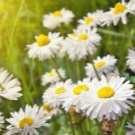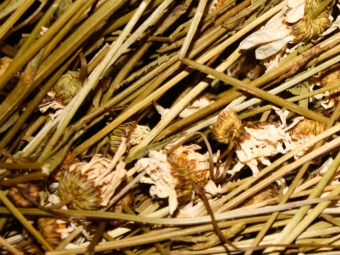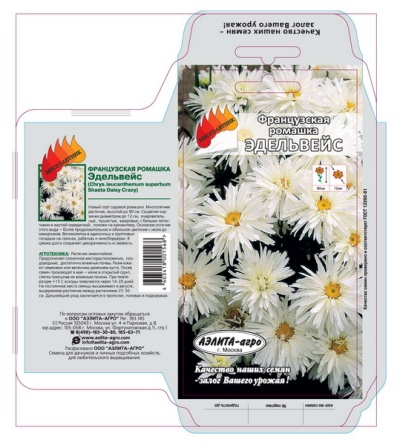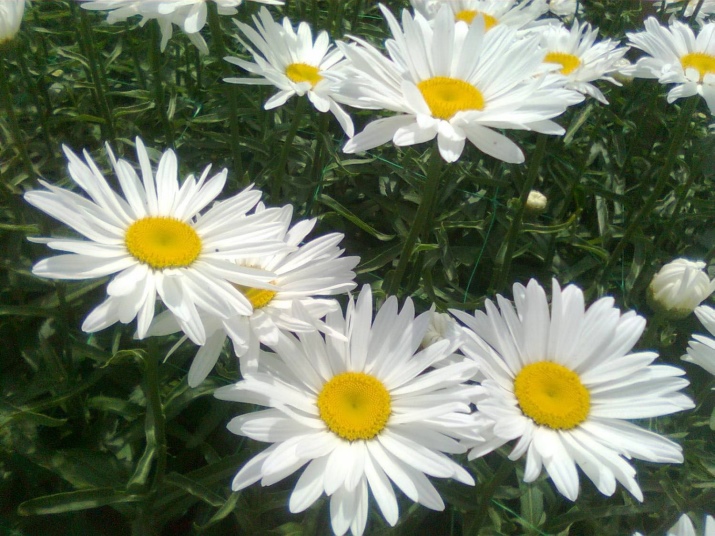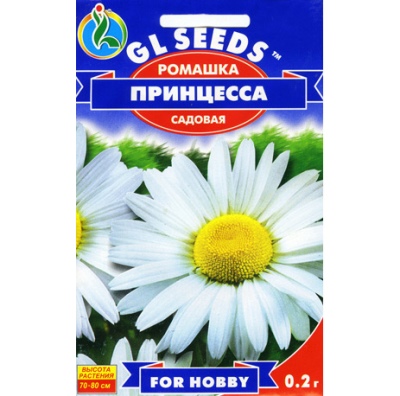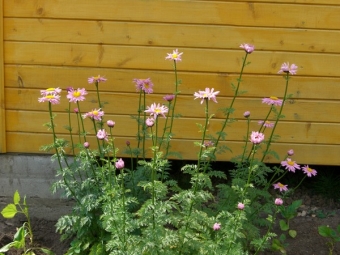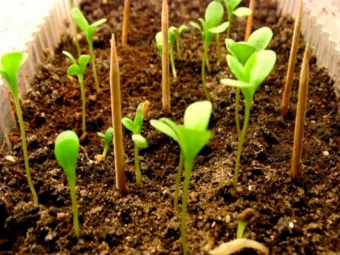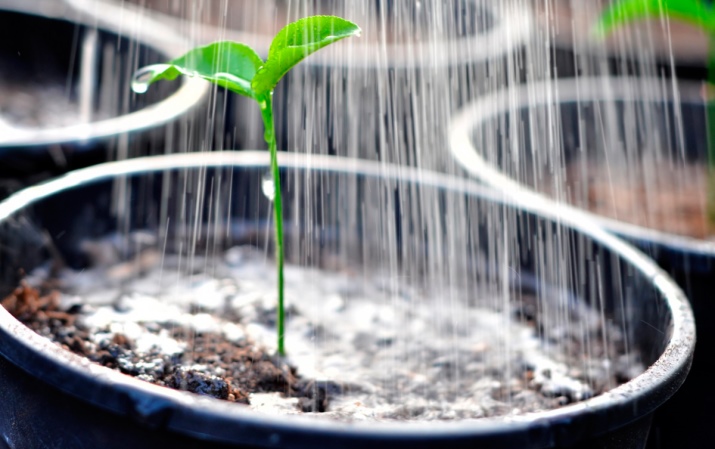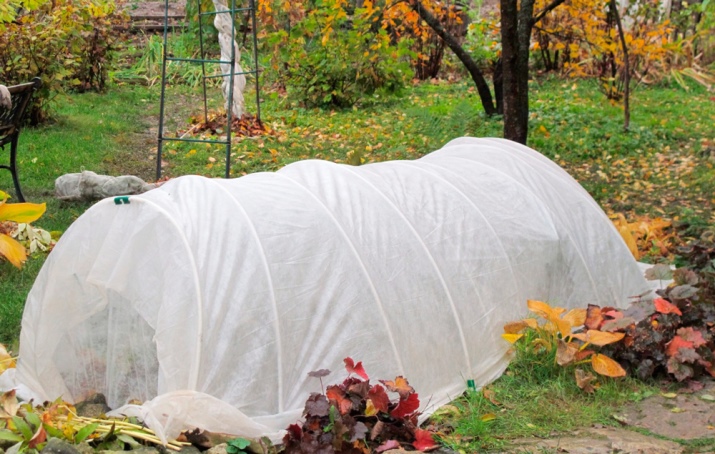Nivyanik (Popovnik) - garden perennial "daisies"
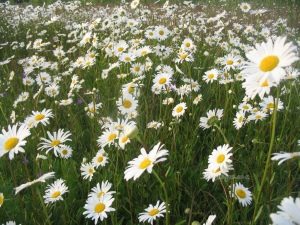
Perennial daisies have long won a lot of fans from around the world. Due to the simplicity and unpretentiousness in the care, novice gardeners often pay attention to this flower. Nivyanik (Popovnik) - garden perennial "daisies" that can decorate and ennoble any space.
Features and Description
Chamomile is a culture known from time immemorial. She was revered in ancient Rome, calling it a sunny flower. This plant can not be confused with any other, although the breeders and brought dozens of new varieties. A distinctive feature of chamomile - white petals and a bright yellow center. But the common brook is a variety that can often be seen, but does not always pay attention to the differences.
Today, Nivyanik is the largest garden chamomile. Bred plant for decorative purposes, there are also terry subspecies. Popovnik has strong, fleshy stems and large inflorescences, reaching 15-20 cm. It is this flower that is so popular among girls, because the “likes-dislikes” divination is known to us since childhood. Nivyanik bush is large enough, and with proper care can grow up to 70-80 cm.
Nivyanik has a bright yellow center, surrounded by delicate white petals. The flower feels best in a sunny open area, but loves the wind. These daisies are perfect for bouquets. If they are cut off and put into the water, they will easily stand for several days without losing their original appearance.
What is different from the usual chamomile?
It is very easy to confuse an ordinary gardener with chamomile, because these two flowers are very similar to each other. The main similarity is in the color of the inflorescence - and the cornfields, and chamomile have white petals and a yellow center. However, there are differences that an experienced gardener can easily see. Nivyanik basket is much more, you should take a closer look, and the difference will be noticeable immediately. Produces a barnyard and more saturated color of the middle.
Another difference can be observed in the leaves of these two plants. Chamomile has soft, tender leaves and fragile stems, but the nyavnyak has a fleshy and thick stalk. In addition, on ordinary daisies there are always several inflorescences on the stem, but on the gardener there is always one. Distinguish it and dense, strong leaves, completely without softness. Nivyanik is a perennial culture, but chamomile is only enough for one season.
Are there any beneficial properties?
Many people mistakenly use the medicine plant for medical purposes, confusing it with pharmaceutical chamomile. Of course, the medicinal properties of the pharmacy (medicinal) chamomile, and you can not argue with that. Chamomile is actively used in cosmetology, alternative and traditional medicine. But this does not mean at all that the cornfield as a plant is useless. On the contrary, he has a lot of positive qualities.
With it, it is easy to get rid of health problems - the nursery can improve immunity, as well as expel waste from the body and toxins. It is an excellent sedative to help strengthen the nervous system. Still nivyanik is a good analgesic and healing medicine. Children plant normalizes sleep, strengthen bones and teeth, relieve diaper rash and rashes. In adults, it prevents the formation and development of malignant tumors, hormonal disruptions and endocrine disruption.
Sorta
French chamomile "Edelweiss" is a relatively new plant variety that is rapidly gaining popularity. This unique variety has high resistance to frost, as well as exuberant flowering. A tall stem of a flower ends with a terry fluffy basket, from which the yellow middle peeps out.
Looks amazing and large "Royal" daisy. This perennial plant with large flowers can grow up to a meter in height.
Fluffy specimens stand out among the many varieties.“Terry” daisy, “Crazy Daisy”, “Chrysanthemum” - all these subspecies are distinguished by a really airy inflorescence, pleasant to the touch. These varieties have a high large stem and dense leaves. It is best to plant them in groups, then an interesting entourage is created.
A short and rather pretty flower is the daisy "Princess". It blooms from July to the cold. The height of the variety is 30 cm, and the diameter of the flower is about 8 cm. It is ideal for planting in curbs.
Worthy competition for this variety will be "Canadian Chamomile" or "Giant." Huge stems approaching two meters can impress anyone.
Those who like unusual bright colors, like the "Persian" daisy. The abundance of colors, from pale pink to rich purple, allowed this plant to occupy a special place in gardens and alpine gardens.
The subspecies of this variety, "Robinson", is a rather large shrub with many inflorescences.
"Persian" chamomile grows lush and lush, and show greater resistance to frost.
Garden chamomile "Leukantemum" is another name for the cornflower. During the season the plant can please the owners with its flowering several times.
Beautiful "Alaska", which grows in length by a meter, blooms profusely throughout the season. It tolerates drought and frost well, and it can be planted by winter.
Another giant among the daisies - “Winner”, has small buds, but it blooms magnificently for several years in a row.
Elegant varieties "Mayfield", "Fiona Goghill", "Sunny Side" will serve as a worthy decoration for any design. Fluffy white petals in small inflorescences look romantic and gentle.
The tiny “Alpine” daisy looks touchingly. Branched stem with a large number of flowers allows you to plant this variety, even separately from others. A thick terry "Engelina", although it loves light soil and top dressing, looks quite compact and can be planted in groups or separately.
Nivyanik "Snow White" - the perfect plant for flower arrangements. Feels good in cut form in bouquets. Full beautiful bud allows you to decorate the most simple lawns. And the magnificent “Grand Illusion” looks great against the background of ornamental shrubs and artificial edges.
Colour
Undoubtedly, the white color is the most popular among the nivyanik. For many, it is associated with modesty, cleanliness and freshness. But there are many other bright shades that are no less attractive. For example, an unusual red daisy. The long-term winter-hardy Firethrum immediately draws attention to itself with a rich touch of petals.
Blue or blue Felicia daisy, imported from South Africa, also looks very majestic. Difficult in cultivation, this variety, however, is gaining popularity. After all, not many people know that in general there are blue "daisies". "Felicia" is used to design borders, flower pots, large flowerpots, rock gardens.
Variety "Doronikum" or yellow chamomile, widely distributed on the mountain plateaus. However, since the plant has been cultivated, it can often be found in landscape design. Doronicum has a yellow, sunny color, large baskets of inflorescences and large stems. In the cultivation of this variety is nothing complicated, the plant is very unpretentious. Planting yellow chamomile is recommended next to large species of flowers - peonies, delphinium.
When to plant?
Since there are a lot of varieties of garden daisies, there are also different planting rules. There are several ways to plant a plant correctly - mainly with the help of seeds and seedlings. If you want to immediately grow bushes in the open field, sow a cornfield in early May. In a few weeks, shoots will appear that will grow in the summer. By the fall, your daisies will bloom, pleasing the eye.
Seedlings for seedlings should be planted in early March.Thanks to this method, by the beginning of summer one can get formed camomile bushes. And in mid-June, the plant blooms profusely. Especially resistant breeds, such as "Alaska", are not prohibited to sow by winter. If you properly care for seedlings, strong stalks with fluffy buds will grow to the end of spring.
How to plant and grow?
It is not always important what method to choose for growing cornfield - they are all quite effective. The most well-known methods - seedling, seed and division of the bush.
In the open ground
The first method of growing seedlings from their own seeds is especially fond of novice gardeners. This is a fairly simple technique - the seeds simply sow directly into open ground. Choose a sunny, warm place with slightly acidic soil, in which the best seeds will be taken. The optimal time for landing is May, when it will be warm and dry. It will be necessary to fertilize the earth with a complex for ornamental plants, as well as with vitamins and minerals.
Since chamomile seeds are rather small, it is not always convenient to distribute them. Therefore, a good solution would be to thin out the emerged shoots. Sowing the seeds, sprinkle them with a very thin layer of earth, then they will germinate earlier and be stronger. Water sprouts regularly, and in case of frost, cover them with plastic wrap. When the seedlings are strong, you can thin them out, leaving a distance of about 40 cm between the plants.
The second, seedling method is more reliable than the first, but more effort will have to be made. You should not choose massive containers, it can be limited to compact pots or boxes. At the bottom of the pot, put quality drainage, accumulated moisture can harm the seedlings. As in the first case, the seeds should be covered with a thin layer of soil, and it is better to just push them. Until shoots appear, keep the container in a warm place under the film and often spray it with water.
Growing cuttings - the third effective method of obtaining new bushes. The best time for such a procedure is early spring. As carefully as possible, dig up a bush of a gardener, while not using sharp tools. Divide the bush into several parts and plant in a well prepared in advance. Fresh bushes need regular watering and mineral dressing.
At home
Nivyanik - so unpretentious plant that it is easy to care for it even at home. The best place for the new guest will be the south side, because all the daisies are very fond of heat and sunlight. For planting, select a shallow container of good width, optimally white. Drainage should be placed at the bottom of the container so that the liquid does not linger in the soil. A universal soil consisting of sand, earth, rotten sawdust, and ash is ideally suited as land.
In the fall, the plants will continue to bloom if they have enough light. If necessary, arrange artificial light. At the end of autumn shoots need to be cut, and the pot itself rearranged in a cool room. If necessary, water the plant until the end of February, waiting until it starts growing again. When the first buds appear, take the cornfield to favorable conditions - a warm and sunny room.
Then it is worth starting a little to fertilize chamomile mineral supplements. Watering transfer to the summer mode, in addition, you can and sprayed with dispensed water from the sprayer. In the heat of the plant will feel good on the balcony, blown by the breeze. Try not to overdry the soil - resistant daisy will not die, but the flowering will not be abundant. Every few weeks, water it with warm water and add fertilizer to flowering plants.
You will find some more useful information about planting a berth in the video below.
Reproduction and transplanting
Very good perennial garden chamomile seeds multiply. You can start the process in the last days of March.For this fit seedling method of cultivation. Sort out the leaflets into separate containers, and when the last frosts take place, plant them in place, covering them with foil. As soon as the seedlings grow, remove the film so that the seedlings are not burned.
In the process of growth, seedlings must be regularly watered and weeded. With the right approach, chamomiles will be ready for planting in open ground by August. This method of reproduction is quite simple and does not require much effort, but the second method is more effective. It is called the "division of the bush" or "grafting". Thanks to this technology it is possible to obtain large resistant specimens.
So that the plant always blooms well and pleases its owners, plant the bushes about once every three years. Without this rule, chamomiles will grow strongly, tangle with each other, and their flowers and stems will become small and thin. In addition, the presence of old roots will prevent the young growth of shoots. Be sure to prepare a fresh soil, well-flavored with organic fertilizer. With a lack of humus, bring it directly into the furrows intended for planting.
Before planting, it is also worth digging a plot, freeing it from old roots and weeds. Pay special attention to the larvae of Khrushchev - these lovers of daisies can negate future efforts. The best time to transplant bushes - the beginning of autumn. At this point, the plants will start blooming and be ready to reproduce. Ideally, there will be warm rainy weather for a few days after transplanting.
For cuttings, choose the largest and strongest shoots. Sprinkle the soil abundantly with sand and pour potassium permanganate. Dip the cuttings into the water and shrink vertically. It remains only to close the escape with a plastic bottle or jar. At first, keep the stalk in the shade, and water it abundantly. You can remove the top container after the appearance of the first good leaves.
How to care?
Despite the fact that the nivyanik is a rather resistant plant, good care of it is nevertheless obligatory. First, do not forget to regularly water the chamomile. Frequent and timely water regime will provide the plant with lush flowering and strong strong shoots. This is especially true on hot days when the earth tends to dry out quickly. Although the nivyanik is drought-resistant, the bottom layer of the soil should still be well-moistened.
Frequent weeding is another bonus to the health of the plant. A large number of weeds injure the young root system, preventing the growth and development of seedlings. Such weeds are recommended to regularly clean, then the plants will not only be healthy, but also accurate. In addition, the risk of occurrence of various pests will be reduced to a minimum. A prerequisite is the loosening of the soil - this rule will help soil conditioning.
Top dressing is very important for cornflower, absolutely all varieties react positively to additional fertilizers. This is especially true during the period of violent growth and flowering. It is best to feed the plant as follows. First, water the soil well, then apply fertilizer and water again carefully. Thus, there will be a maximum assimilation of all minerals.
Novice gardeners are often interested in when to prune shoots. It is desirable to do this once every 3-5 years, strictly after the flowering of the bush. Pruning of the shoots will help to rejuvenate the plant, it will not allow it to die. To carry out such a procedure, cut the shoots together with the roots on one side of the bush, and fill the appeared space with fresh soil. After this, it will only be good to water the cornfields.
It must be remembered that daisies are very sunny flowers, so provide them with constant access to the light. You can not plant them in the shade of trees or near the walls of houses - having lost a source of light, the plant will quickly disappear. By winter, the upper part of the cornfield is cut, and the root remains in place. If the bushes are relatively young, help them survive the winter, well covered with foliage.Mature plants cope well on their own.
There is nothing difficult in the collection of seeds. When the flower dries, it must be cut and placed until completely dry in a dark room. After the process, remove the seeds, sift and wrap in paper. The work is ready, it remains only to keep the obtained seeds in a dark and cool place.
Those who love chamomile, it is worth remembering that with insufficient care plants can pick up various diseases. Powdery mildew, rust, fusarium are very popular diseases. To prevent such moments, often inspect the plants, remove weeds in a timely manner and loosen the soil.
As a preventive measure, occasionally, nivyanik can be treated with fungicides that will not allow infection to get into the root system. But it is better to immediately remove the elements spoiled by gray mold by the root - this disease tends to spread rapidly.
Application in landscape design
Despite the seeming modesty, daisies for many years remain the most popular flowers for decorating gardens and lawns. Nivyanik look great on a bed - for this they need to be planted together.
They are a great decoration for flower beds and lawns, their delicate white flowers will delight every guest.
Chamomile is often planted not for a solitary existence - it gets along perfectly with almost all types of plants.
Even in the majestic rose gardens, the cornfields look fresh and fun.
To get an indescribable style "Russian garden", plant camomiles with contrasting colors. This role will be successfully fulfilled by poppies and cornflowers. The combination of light negligence with beauty is the basic principles of the Russian Garden. You are free to plan your own design, sitting in the chaotic order. And you can complement not only poppies, but also lush bright roses and bells.
English and French style is a combination of rigor and symmetry. Romanticism such gardens will add not only daisies, but also a lot of decorative elements. A small elegant fountain, stone benches, bushes of unusual shapes will suit.
And if you want an abundance of white, try to create a "white" garden. Here, snow-white cornflowers can coexist with the refined lily, delphinium, chrysanthemums.









